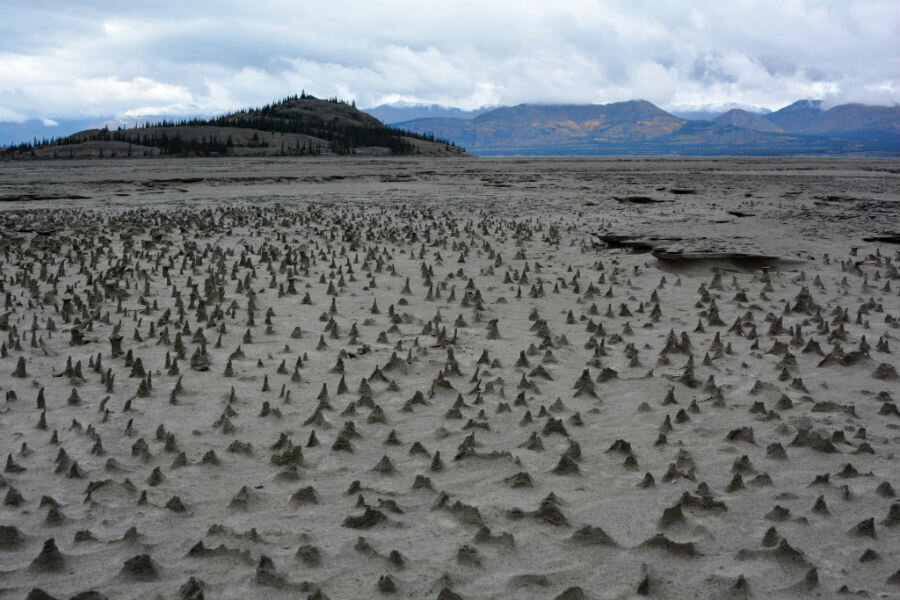How climate change dried up a Canadian glacier river in a matter of days
Loading...
Last August, a small group of scientists set out for some routine fieldwork at Slims River, which feeds Kluane Lake, the largest glacially fed body of water in northwest Canada's Yukon Territory. When they arrived at the site of the fieldwork, however, the 15-mile long river had all but vanished, with only a thin trickle of water remaining where 10-foot depths had been common only a month before.
The scientists reviewed satellite data and other measurements and found that the river had vanished over a stunningly fast four days – between May 26 and 29 – in an unprecedented modern example of a geological phenomenon known as "river piracy."
The scientists determined that the climate-change related receding of the Kaskawulsh Glacier, the source of Slims River, was responsible for the sudden disappearance. In a study released Tuesday, the researchers noted that the glacier had shrunk to a point where its water was entirely redirected towards the Kaskawulsh River, which was usually fed by the glacier along with Slims.
"River piracy in this context means one river taking water from another in some unplanned sort of way," Mark Davis, senior research fellow and director of the Tulane Institute on Water Resources Law and Policy in New Orleans, tells The Christian Science Monitor via email. "It is a metaphor," he adds.
Mr. Davis tells the Monitor that this kind of sudden shift is probably not unprecedented, since glaciers and rivers are naturally dynamic, responding to the ebb and flow of weather patterns and temperatures. Still, the disappearance of a whole river in less than a week took the researchers by surprise.
"Geologists have seen river piracy, but nobody to our knowledge has documented it happening in our lifetimes," said lead author Dan Shugar in a statement from the University of Washington Tacoma. "People had looked at the geological record – thousands or millions of years ago – not the 21st century, where it's happening under our noses."
At its widest points, Slims River spanned 150 meters (492 feet), carrying water from the glacier into the Kluane Lake, which then eventually flowed into the Yukon River toward the Bering Sea. This pattern remained unchanged for centuries, until Kaskawulsh Glacier retreated under a period of intense melting during the record-breaking temperatures of 2016.
"What we found was the glacial lake that fed Slims River had actually changed its outlet," Dr. Shugar said in the statement. "A 30-meter (100-foot) canyon had been carved through the terminus of the glacier. Meltwater was flowing through that canyon from one lake into another glacial lake, almost like when you see champagne poured into glasses that are stacked in a pyramid."
The abrupt shift in water flow has already had significant environmental repercussions. The now nearly dry riverbed has exposed once-watery sediment to the open air, causing dust storms in the region. Kluane Lake has also seen a drop in water level, leaving vacation cabin docks high and dry in the Yukon's largest lake, a popular tourist destination.
According to the study, which was published in the journal Nature Geoscience, the research team used satellite data to determine that the sudden river piracy was a direct affect of climate change driven by the addition of greenhouse gases into the atmosphere from industrial sources, accelerating the glacier's continuous retreat since the end of the Little Ice Age the 1800s.
So can we expect glacial rivers to disappear elsewhere? Not necessarily, according to Shugar – river piracy on this timescale is still very rare. But that doesn't mean there is no cause for concern – ice melts have already led to rising oceans and other negative environmental consequences of human-caused climate change.
"So far, a lot of the scientific work surrounding glaciers and climate change has been focused on sea-level rise," Shugar said in the statement. "Our study shows there may be other underappreciated, unanticipated effects of glacial retreat."
Initiatives like the Paris Agreement, aimed at reducing the world's carbon emissions, are helping to minimize further problems associated with ice melt. But in the meantime, there's not much the average person can do beyond educating themselves about the climate and responding to these sorts of issues as they occur, says Davis.
"The retreat of glaciers is important for reasons beyond river piracy," he says. "These include changes in flooding risk, changes to the ecology, changes to agriculture and public water supplies, and significant impacts on cultures and development patterns. These things are already happening, but are often harder to pin down since there is not a catchy phrase to sum them up and because the range and scale of impacts is much larger and harder to deal with."
"Glaciers are hard things to boss around," Davis adds.






